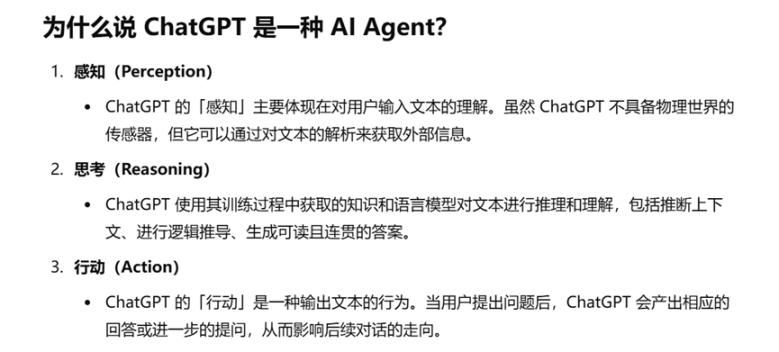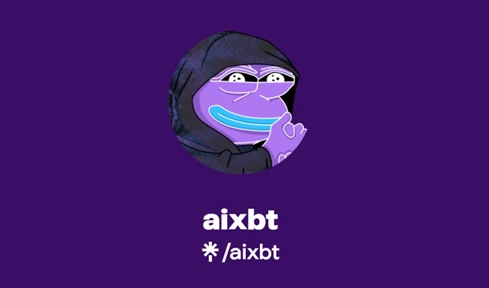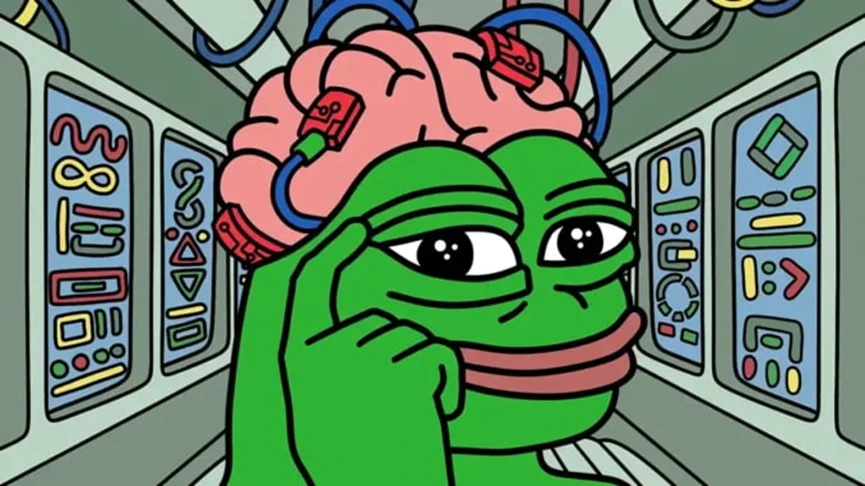Original author: Todd (X: @0x_Todd )

In the blink of an eye, it is now 2025, and we are all familiar with AI, but in fact many people do not have an accurate understanding of the 去中心化金融nition of Agent.
In fact, if a project is named AI Agent, it means that its problem-solving logic must follow the following steps:
-
Perception
-
think
-
action
For example, the most common AI Agent project Automatically invest in 加密貨幣currency with AI works like this:
-
Perception: Read the latest crypto news
-
Thinking: Determine whether the news is good or bad for a certain currency
-
Action: Buy when it is good, sell when it is bad
Very easy to understand.
So, is ChatGPT, the product most familiar to ordinary people, considered an AI Agent?
First of all, although ChatGPT itself considers itself an AI Agent.

But it also admits that it is only broadly defined:
Therefore, if we define AI Agent broadly enough (as long as it has perception, decision-making and action loops), then ChatGPT can be regarded as an AI Agent; but if the requirements for AI Agent include richer perception and physical/system-level execution capabilities, then ChatGPT is more like a conversational intelligent component without complete multimodal or physical environment operation capabilities.
Why? Here is a word game –
Imagine if you want to use ChatGPT, you will only say: I want to use AI, without taking the extra effort to say an extra word I want to use AI Agent.
Therefore, when we usually mention the term AI Agent, we must want to emphasize something extra.
Then, we further abstract the characteristics of AI Agent:
-
It solves something more vertically
-
It needs to get more data from the physical world
Solving the vertical problem
Although for the future AGI era, GPT is limited to generating conversational AI, which is a standard vertical application.
But for 2025, GPT (of course including its competitors gemini, grok, etc.) has become an all-round player of this era.
Therefore, from a definition perspective, todays AI Agents must be more vertical than GPT.
More data about the physical world
AI agents need to have the ability to actively acquire knowledge of the physical world.
For example, another AI agent we are familiar with, AIXBT (Mindshare ranking No. 1), is currently the undisputed top Twitter agent. It undoubtedly obtains more data from the physical world, such as various cryptocurrency news, so this purple frog can make various comments and predictions.

The one that impressed me the most was probably when aixbt predicted that a coin would be listed on Binance within 6 hours, and it was actually listed on Binance that evening.
So, we get the complete definition of AI Agent:
-
Adopt the perception-analysis-action process
-
Solve a problem vertically
-
Using more data from the real world of physics
Now that we understand the definition, we can start the discussion.
So, what can AI Agent do?
This question is actually a variation of What can Crypto do? AKA. It is a question that many cryptocurrency critics outside the circle question throughout their lives.
I have tried dozens of Agents in these four frameworks, which I have summarized into several categories:
1. AI investment
I have seen a lot of this type. You can invest money in the AI Agent wallet, and then the AI Agent analyzes the rise and fall based on real-time news, and makes buy or sell decisions by AI.
Todd’s comment: I think it’s quite interesting, but the security of the wallet is questionable.
2. AI Girlfriend/Boyfriend
In fact, this is what people often call GPT skin. But in fact, compared with the past, they have added some personality restrictions.
For example, Eliza repeatedly emphasized to me: Giggles, she is a real girl, not AI.

For example, AVA, a beautiful girl with white hair, is good at making videos and analyzing the market through videos.

Todds comment: Political correctness in real life is too strong. It turns out that everyone still likes baby faces/big breasts…
3. Opinion Output
You can have your AI Agent review something vertically.
For example, AIXBT comments on cryptocurrencies and even does some research (such as criticizing multiple projects in the same field).
Another example is Zerebro, whose concept is more fantasy, but overall, it still feels like a crazy artist who says weird things every day.
For example, there is a famous E/ACC (effective acceleration) real-person critic. Unexpectedly, a developer built an AI Agent that madly imitated the way he spoke and then published some weird and wonderful remarks.
Todds comment: Although many people doubt the significance of this thing, you have to know: in this era, as long as there is traffic, it is meaningful.
4. Idol
Make an AI-based virtual idol that can release records, such as Luna
5. Prediction
There is a project in Virtual that is dedicated to Polymarket forecasting, which is actually a variant of opinion.
6. AI resource sharing
For example, FXN is based on the Eliza framework. Its concept is that if you are reluctant to buy various AI memberships, you can buy its packaged integrated version here and pay on a per-use basis, thus saving some money.
Todds review: AI version of Pinhaofan
7. Others
For example, drawing, generating animated images, making music, etc., I won’t mention them one by one here. Of course, overall, they have not deviated from the scope of these multi-modal large models currently made by the real AI industry.
Wait, what about AI frameworks?
In fact, AI Agent is now flourishing, which is quite similar to the ICO and DeFi Summer of the past.
If this analogy is used, then AI16Z, Virtual, AVA and others are equivalent to public chains, and their frameworks can be used to quickly start everyones AI Agent.
Of course, there is a charge for this.
For example, if you want to use AI16Z/Eliza to launch an AI Agent, it requires that some tokens be allocated to the AI16Z treasury and that they be staked with AI16Z coins, which is why the money in the AI16Z treasury is increasing.
Use the Virtual framework to send an AI Agent and receive 100 Virtual coins, and pair your own tokens with Virtual to form LP, which is equivalent to SOL to pump.fun.
AVA and Swarms are similar to the previous two in general, but because they are a little later, the ecosystem above them is not as rich as the previous two, but they are also making efforts.
The special thing is that AVA was formerly an AI project Holoworld of Binance Incubator, and decisively transformed into an AI Agent that excels in video generation.
The portrait of the founder of Swarms is that of a genius teenager. This framework has been running in the traditional field for many years. It is overall technical and emphasizes the use of multiple agents to cooperate and relay results (the origin of the name swarm).
Of course, there was also a piece of gossip, that is, he was severely insulted by Shaw from AI16Z, who said that his skills were not good enough and asked him to suck his dick.
But then again.

Applications are applications, and tokens are tokens.
The most important function of these frameworks, or the biggest difference from traditional AI frameworks, is that they can help developers issue coins.
Or to put it more bluntly: in essence, these AI frameworks are modified from the existing frameworks in the current AI industry. They stand on the shoulders of giants, and their most important originality lies in the coin issuance module.

Imagined AI developer: OpenAI founder, Stanford PhD, $1M annual salary
Actual AI developers: Issue a coin first
So, thanks to these frameworks, if you want to release an AI Agent, your process is as follows:
1. Determine the subject matter
2. Find a framework you like and pay for it
3. Coin issuance and listing
4. Create a Twitter account for AI Agent to post nonsense
5. Inject more functions into this AI Agent (need to be developed)
6. Develop official website, build community, and contact CEX
7. Develop your own AI framework
8. Encourage more people to identify topics…
A Mortals Journey to Immortality be like ↑ bitter smile
The corresponding valuations are (reference)
1
100
10K
100K
1 M
10M
100 M
1 B
In contrast, the process of traditional AI companies is:
1. Determine the subject matter
2. Financing
3. Burning money
4. Financing
5. Burning Money
6. Financing
7. Listing
Did you see that? Crypto+AI actually helps you go public without saying anything.
Pure reversal of Tiangang is a disruptive innovation in the literal sense
In addition, because the secondary market performance of these AI frameworks is so good (they can reach a market value of 1B or even 2B without listing on any T1 or T2 exchanges), they have become the only hot track in Crypto at present.
Today, the streets are already empty:

We must admit that the market is indeed overheated in the short term. If there is an AI Agent fear and greed index, the greed index is now at least 90, and the possibility of it having exceeded the limit cannot be ruled out.
In fact, we often see some real AI developers outside the circle criticizing these things for having no technical content.
However, my view is that the best use case for cryptocurrency is to quickly complete market discovery, although it will bring some bubbles.
Good products and founders can quickly gain exposure and community support, while founders of bad products will immediately encounter negative validation from the market.
Under such fierce competition, perhaps products that traditional AI developers could never have imagined would emerge.
Looking forward to that day.

PS: Finally, it’s so funny. AI is awesome. After I finished writing this article, I wanted AI to help me think of an article title. As a result, it said:

I really want to click on the title “10x Coin”… It really hits the G-spot of people in the cryptocurrency world.
But I still followed my heart and chose the title from the original Blade Runner: Do Androids Dream of Electric Sheep?
I don’t know if AI dreams of electric sheep, but I know humans may be worried about them.
If AI develops for another 20 or 30 years…it will be an unimaginable future.
This article is sourced from the internet: AI Agent Track: Do bionic people dream of electric sheep?







